Dec 27, 2017 | advice, supplies
During a recent coin club meeting, someone asked how to create an album or some type of presentation for a custom collection. Whether they are putting together year sets, typeset, or a theme set, there is always the question as to how to create a way to display them.
One typical solution is to purchase the pages that you can slide 2×2 holders in each space. Each page holds 20 of the 2x2s and the pages can be placed in any binder.
Experienced collectors know that the typical 2×2 holder is ugly. They are either cardboard with an opening covered in Mylar or they are clear plastic flips. And not all flips are the same. Those made with certain plastics, including those that contain polyvinyl chloride (PVC) will damage whatever you put into those holders. Also, some of the older pages contain PVC. Even if the individual holder may be archival safe, the holders are not airtight and will allow the gasses from the PVC to eventually damage the coin.
I found a better solution.
When I started collecting Canadian coins, I started looking for an album or some other way to display the collection. At the time, Whitman had not started selling Canadian coin folders again (they had stopped years earlier). Using the Internet, I began to search for Canada-based coin shops to see what they had in inventory.
-
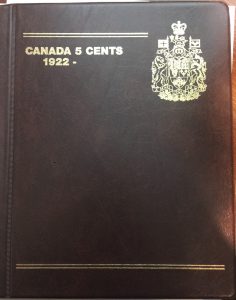
-
Gardmaster Canada 5-Cents Album
-

-
A page from my Gardmaster Canada 5-Cents Album
-

-
Gardmaster Canada Dollar Album
-
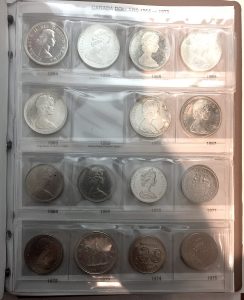
-
A page from my Gardmaster Canada Dollar Album
Just like for United States coins there are only a few options. After doing some research I settled on Gardmaster albums.
Gardmaster albums use clear pages that have a slider where the coins are placed. Pull out the slider and insert your coin or other numismatic collectibles in the pocket. Slide the slider back in and you have a clear page to see both sides and edge of the coin. The plastic they use does not contain a softening agent (like PVC) to keep your collectibles safe.
-
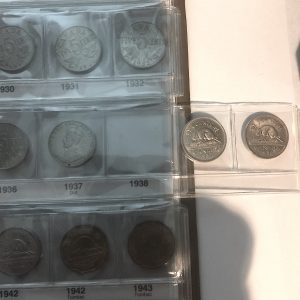
-
Slider slides out to place coins
-
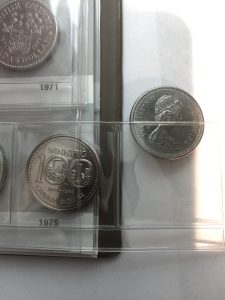
-
Coins are inserted from the top of the slider which holds the coins in place
The covers themselves use a snap closure to keep the pages in place. These covers are thick enough to hold 5 pages comfortably but can be pushed to six. The limiting factor will be the thickness of your collectibles. Adding too many pages will cause the cover to bulge making the presentation less attractive.
Between the pages is a page where information is either printed with the information about the collectible or can be purchased blank for you to add your own information. For my Large Cent collection, I used Brother P-Touch labels to mark the slots for each coin. I tried to make a template using Microsoft Word but was unsuccessful. A more experienced Word wrangler explained what I was doing wrong which will allow me to fix this when I get a chance.
-
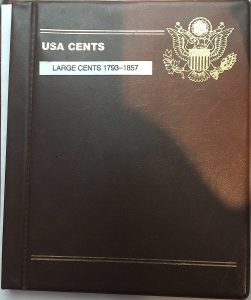
-
Gardmaster Generic USA Cents album I use for Large Cents
-
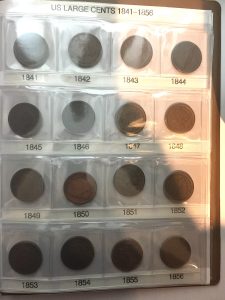
-
One of the pages of my Gardmaster USA Cents Album
Gardmaster, a Canadian company, makes albums for all series of Canadian coins including modern coins. Albums for Canadian coins have the Canadian crest printed on the cover along with the coin’s series.
Gardmaster also makes albums for United States coins that have a heraldic eagle on the cover. Albums are available for all United States series including State quarters, Presidential dollars, and albums with coin types on the cover but no dates printed on the inserts allowing the collector to make their own collection.
Blank covers are also available that include what they call a “World Crest.” I do not know what the World Crest looks like since I have not purchased one.
Gardmaster Pages
- 30 pocket page, fits up to 27mm coins
- 16 pocket page, fits up to 41mm coins
- 2 pocket page, fits proof or mint sets
- 3 pocket page, fits current or small currency
- 9 pocket page, fits up to 52mm coins
- 20 pocket page, fits up to 30mm coins
If you are making your own album, Gardmaster has six-page types to choose from. Most coins can fit into a 30-pocket page that has six pockets in a row and five rows. When I was creating my Large Cent album I thought that was a little tight. I bypassed the 20-pocket page (five pockets with four rows) for the 16-pocket page (four pockets in four rows).
The various page sizes can be mixed and matched depending on your needs.
Currently, I buy the Gardmaster Albums and pages from Brooklyn Gallery Coins and Stamps. When you search for the albums and pages, you need to search for “guardmaster” since they spelled it wrong. Who cares about the spelling—Brooklyn Gallery has great prices and they ship quickly.
Although Gardmaster albums are better looking than 2×2 pages in binders, they are not as good looking as the Dansco, Whitman, or the Littleton albums I have used. The binders remind me of the 1980s that is in dire need of an upgrade. The covers look like they are pressed around the cardboard in the center instead of cleanly wrapped like most covers we are used to using.
My next project is to organize my New York Collection. Currently, these are coins, tokens, and medals in 2×2 holders and flips with most put into the typical binder page. As I gather these items, I am going to figure how I will organize these pieces and buy the appropriate Gardmaster albums for them. When I do, I will fix the template so that I can print the divider page with the information I want using the inkjet printer on my desk.
Apr 30, 2016 | advice, coins, currency, supplies
A reader with questions recently reminded me of a previous version of this article. After reading what I wrote, I noticed a few things that required editing along with some additional information I could add. Rather than keep this to myself, I am sharing so that it can also serve as a reminder to everyone about proper storage.
After putting in the time, effort, and resources to assemble your collection do not just throw it in a draw or closet. Coins, currency, tokens and medals can become damaged if not stored properly. It would be a shame if your collection is damaged when a little effort can keep your collection preserved.
Storing a collection is a matter of dealing with two factors: using archival safe storage materials and the environmental factors of where your collection is stored.
Archival Safety
 All coins, medals, tokens, and currency are made from materials that will react with the environment. Metals will oxidize and tone, some with patterns that intrigue collectors. Paper-based materials can be made from cotton rag or linen that may not break down the same way as paper but can be damaged in a way that will affect its value. The key to storing your collection is to use products made from archival safe materials. Archival safe materials are those made that are not acidic, materials that do not turn acidic over time, or materials that are not too alkaline.
All coins, medals, tokens, and currency are made from materials that will react with the environment. Metals will oxidize and tone, some with patterns that intrigue collectors. Paper-based materials can be made from cotton rag or linen that may not break down the same way as paper but can be damaged in a way that will affect its value. The key to storing your collection is to use products made from archival safe materials. Archival safe materials are those made that are not acidic, materials that do not turn acidic over time, or materials that are not too alkaline.
Acid free means that the pH (potential Hydrogen) measure is 7.0 or less. A pH measure of 7.0 is neutral and greater than 7.0 is basic or alkaline. Although acidic materials will damage your collection, materials too alkaline will also cause damage. Those that produce acid free supplies with materials that is as close to being pH neutral as possible.
It is possible for some materials to be acid free without being archival safe. These are substances that can breakdown over time and become acidic. For example, commercially made paper contains lignin, a bonding elements that naturally occurs in the pulp that helps holds the wood fibers together. While lignin is not acidic it gives offs acids as it deteriorates. To prevent lignin from becoming acidic it must be treated. This treatment involves dipping the paper in a solution that neutralizes the natural lignin.
Another storage item to stay away from are plastic products made from polyvinyl chloride (PVC). PVC is a inexpensive plastic that is used as an additive to other plastics to make softer, more flexible products. One example of a numismatic product that can be made using PVC are the two-pouch coin holders called flips where each pouch is 2-inches square. PVC in itself is neutral but gives off an acidic gas in reaction to atmospheric conditions. The PVC gas will not only react with the coins but will deteriorate the plastic. The result will be a green or gray streaks or blob appearing on the coins.
The gas produced by deteriorating PVC will damage the surface of the coin. Once a coin is damage by PVC it cannot be reversed. There are ways to conserve coins that are damaged by PVC as long as the PVC contamination is discovered early and is only on the surface. Once it mars the surface, the coin is permanently damaged and its value diminished.
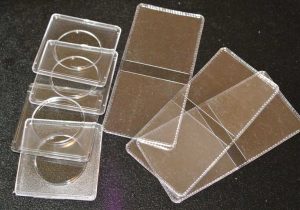
Archival Safe Flips and Cases
Some people like to buy older albums because of they are unique and have a classic look. Those albums may not be made of archival material including paper with active acid from the deteriorating lignin that was not neutralized during manufacture because this was not a concern. Also, cover sliders could be made of PVC or other plastics that are not neutral. If you are not sure whether that used album is safe, it is best to buy a new archival safe album.
Although this discussion centered on coins, the same can be said for currency storage. The only difference will be the size and types of holders.
Environmental Factors
You can use the most archival safe materials but they will not protect your collection from environmental factors. The general rule of thumb is to stay away from the extremes. Do not store your collecting in a place that is too hot or too cold. Try not to store your collection in a place that is too humid or too dry since both could cause your storage materials to react. In other words, the average home with a temperature of 64-78 degrees with an average humidity of 30-percent should not be a problem.
Those living in colder areas where the home heater is being used longer than other areas of the country may have to compensate. Forced air heating systems tend to dry the air that could cause damage to your collection. If you use a humidifier, whether built in to your heating system or a standalone unit, you might consider investing in a hygrometer to keep the relative humidity between 30 and 40-percent.
Where you store your collection also has to be a concern. If you keep your coins in a cabinet, the gasses from the wood and even the paint or stain can cause damage. While wooden cabinets are attractive and practical, you do not want to store your collection some place that could add to the environmental concerns.
Metal cabinets are a better option. Safes and safety deposit boxes in temperature controlled vaults also makes great storage options aside from being able to keep your collection secure.
One of the factors that could cause wood rot in cabinets is excess humidity. If the humidity in your home or where you store your collection cannot be controlled, you should use a desiccant. A desiccant is a substance able to absorb moisture in the air. Two common desiccants are silica gel, the little packets that you see in some packaging, and montmorillonite clay.
Choosing which desiccant to use depends on your situation. If your storage area is not that humid, use silica gel. It well suited for lower moisture area over a longer period of time, about six months. For high humidity areas, use a clay desiccant. Although it will not last as long as silica gel (about three months), clay is more effective at removing moisture where the humidity is higher. Another option is to use a combination, especially during seasons of high humidity. You can purchase silica gel and clay desiccants at many hobby stores and stores that sell collecting supplies.
While there are other types of desiccants, they are not recommended for use around collectibles. Calcium sulfate and calcium chloride uses sulfur and chlorine, both will not react well with the metals of your coins. Activated charcoal can add carbon dust to the air, which can attach itself to your coins. Some have suggested using salt as a desiccant. Salt is made of sodium chloride that would also introduce metal damaging chlorine into the environment.
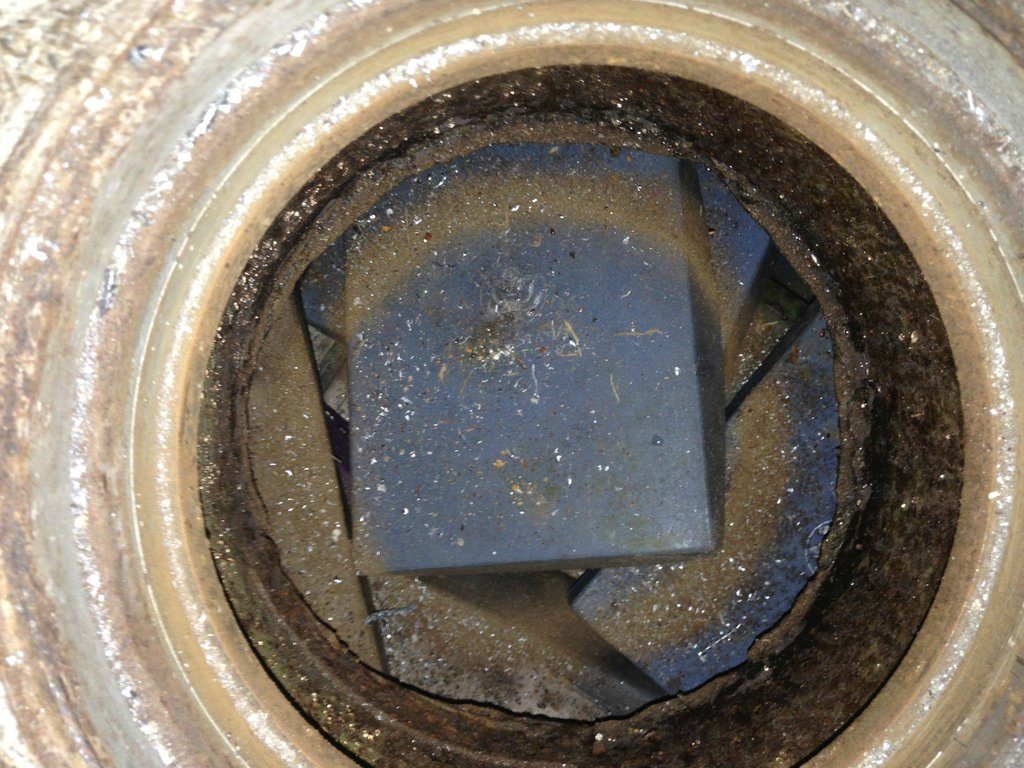
Not all safes are safe for coin storage. Click on the image to read the story about a safe found in the house of the writer’s late grandfather.
Choosing Storage Products
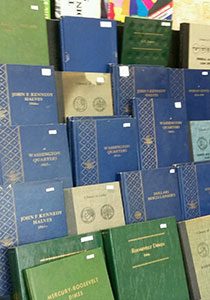
Be careful, old coin albums may not be archival safe!
Albums are popular for raw coins collected in the published series. You can find albums for many series from different manufactures to suit your tastes. Each manufacturer has its own distinct color and style. The difference is your personal preference.
Coins that have been encapsulated by third-party grading services may present different issues for storage and display. While there are a few manufacturers that make a special page to fit the grading service’s holders, collections made up of coins encapsulated by different grading services can be stored in boxes.
When storing grading service holders it is important to remember that the holders are not considered airtight. Third party grading services uses sound waves to melt the halves of the plastic holder to bond them without using chemical adhesives. While this type of sonic seal is strong, it can be subject to breaking if the encapsulated coin is mishandled. Additionally, whatever contaminants were in the air around the time the slab was sealed would be trapped with the coin.
Although most encapsulated coins could be stored in a standard plastic case, those who want extra protection should consider storing the slabs in special archival quality inserts or polyethylene bags.
When storing your collection you can use the same archival quality containers that are used by organizations like the United States Archives or Library of Congress. Although many of the containers may be coated with an alkaline buffer should not be a deterrent. Since your coins are in another holder, whether encapsulated or within an album, the buffer will maintain a barrier between your collection and the storage box that should not hurt your coins.
Although proper storage of your prized collection is important, do not make it more important than your collection. Be careful how you store these items but do so in a way you can still enjoy what you collected.
Image Credits (in order of appearance)
May 15, 2012 | education, supplies
Over the last few weeks, I have been discussing the storage of a collection with a reader via email. After researching the advice, I thought it would be good to share it with all of my readers so that you can better preserve your collection. Storing a collection is a matter of dealing with two factors: using archival safe storage materials and the environmental factors which your collection is stored.
Archival Safety
All coins, medals, tokens, and currency are made from materials that will react with the environment. Metals will oxidize and tone, some with patterns that intrigue collectors. Paper-based materials can be made from cotton rag or linen that may not break down the same way as paper but can be damaged affecting its value. The key to storing your collection is to use product made from archival safe materials. Archival safe materials are those made without acidic materials or materials that do not turn acidic over time.
Acid free means that the pH (potential Hydrogen) measure is 7.0 or greater. A pH measure of 7.0 is neutral and greater than 7.0 is basic or alkaline. Although acidic materials will damage your collection, materials too alkaline will also cause damage. Those that produce acid free supplies with materials that is as close to being pH neutral as possible.
However, it is possible to be acid free without being archival safe. All paper contains Lignin, a bonding elements that naturally occurs in the pulp used to make paper that holds the wood fibers together. While lignin is not acidic, it gives offs acids as it deteriorates. If the lignin is not treated during manufacture, you can still have acid free paper but will become acidic as it deteriorates over time. The treatment involves dipping the paper in a solution that neutralizes the natural lignin.
Another storage item to stay away from is made from polyvinyl chloride (PVC). PVC is a very inexpensive plastic that is used as an additive to other plastics to make softer, more flexible products such as 2×2 flips used to store coins. PVC in itself is neutral but gives off a gas in reaction to the atmosphere that is acidic. The PVC gas will not only react with the coins but will deteriorate the plastic. The result will be a green or gray streaks or blob appearing on the coins. Because the PVC gas is acidic it will damage the surface of the coin. Once a coin is damage by PVC it cannot be reversed. There are ways to conserve coins that are damaged by PVC as long as the PVC contamination is on the surface. Once it mars the surface, the coin is damaged and its value diminished.
When purchasing plastic or clear storage items, hard plastics or those made of Mylar are the best choice. Capsule manufacturers use a neutral plastic that does not contain PVC while those that make 2×2 flips use Mylar. The makers of 2×2 cardboard holders also use Mylar and the cover sliders found in albums.
Some people like to buy older albums because of they are unique and have a classic look. Those albums may not be made of archival material including paper with active acid from the deteriorating lignin that was not neutralized during manufacture because this was not a concern. Also, cover sliders could be made of PVC or other plastics that are not neutral. If you are not sure whether that used album is safe, it is best to buy a new archival safe album.
Environmental Factors
You can use the most archival safe materials but they will not protect your collection from environmental factors. The general rule of thumb is to stay away from the extremes. Do not store your collecting in a place that is too hot or too cold. Try not to store your collection in a place that is too humid or too dry since both could cause your storage materials to react. In other words, the average home with a temperature of 64-78 degrees with an average humidity of 30-percent should not be a problem.
Those living in colder areas where the home header is being used longer than other areas of the country may have to compensate. Forced air heating systems tend to dry the air that could cause damage to your collection. If you use a humidifier, whether built in to your heating system or a standalone unit, you might consider investing in a hygrometer to keep the relative humidity between 30 and 40-percent.
Where you store your collection also has to be a concern. If you keep your coins in a cabinet, the gasses from the wood and even the paint or stain used to cover the wood can cause damage. While wooden cabinets are attractive and practical, you do not want to store your collection some place that could add to the environmental concerns.
Metal cabinets are a better option. Safes and safety deposit boxes in temperature controlled vaults also makes great storage options aside from being able to keep your collection secure.
One of the factors that could cause wood rot in cabinets is excess humidity. If your home or where you store your collection cannot be controlled, you should use a desiccant in the area. A desiccant is a substance able to absorb moisture in the air. Two common desiccants are silica gel, the little packets that you see in some packages, and montmorillonite clay.
Choosing which desiccant to use depends on your situation. If your storage area is not that humid, use silica gel. It well suited for lower moisture area over a longer period of time, about six months. For high humidity areas, use a clay desiccant. Although it will not last as long as silica gel (about three months), clay is more effective at removing moisture when the humidity is higher. Another option is to use a combination, especially during seasons of high humidity. You can purchase silica gel and clay desiccants at many hobby stores and stores that sell collecting supplies.
While there are other types of desiccants, they are not recommended for use around collectibles. Calcium sulfate and calcium chloride uses sulfur and chlorine, both will not react well with the metals of your coins. Activated charcoal can add carbon dust to the air, which can attach itself to your coins. Some have suggested using salt as a desiccant. Salt is made of sodium chloride that would also introduce metal damaging chlorine into the environment.
May 18, 2008 | Canada, supplies
Whitman Publishing sent out an email notice announcing that they will be selling a complete line of folders for Canada coins. With a shipping date of May 23, Whitman’s 12 new folders will include large cents, small cents (2 folders), 25 cents (5 folders), and dollars (4 folders).
The announcement did not mention folders for the 5 cents, 10 cents, and two dollar (Toonie) coins.
When I started collecting Canadian coins a few years ago, I first went to Whitman for folders and albums. That is when I found that Whitman discontinued producing Canadian coin folders. I bought a few used folders from the secondary market, but were disappointed with their quality. After a search and then having a conversation with a Canadian coin dealer, I found Gardmaster Coin Albums.
Pockets in Gardmaster albums are in a slider that fits into sleeves within the album page. Slide the strip from the page, place the coin in the correct pocket, and slide the strip back into the page. Coins remain secured within the album. Gardmaster says the materials are archival safe.
Gardmaster albums use a snap-lock system to keep the pages secured. Although the album is not as attractive as the Whitman or other albums, the system is highly effective. If you don’t like their album, the pages will fit into almost any binder.
After having problems with the variable size of early US large cents fitting in the “standard size” Whitman folders, I bought a blank Gardmaster US Cents folder for that collection.
Although I have my favorite place to buy Gardmaster albums, others sell them in context to replace old Harco Coinmaster albums.
I highly recommend Gardmaster albums for the Canadian coin collector and others looking for a different type of album.
Mar 3, 2008 | Baltimore, coins, shows, supplies
After having a procedure done on my arthritic knee, I made sure that my doctor said it was all right to travel to attend the Whitman Baltimore Coin and Currency Convention. I could not miss the show. It is the largest regular show in the area—although the ANA Worlds Fair of Money will be held in Charm City this summer. When my doctor said that there should not be a concern, I made plans to attend on Saturday.
The procedure left me a little sore which made sleeping an issue. After waking up late, I made it to the Baltimore Convention Center by 3 o’clock. One of the problems with arriving later on Saturday is that at least one-third of the dealers closed and left the convention center. I tried to understand the situation from the dealer’s perspective, but when I am walking the bourse floor with a pocket full of money and a half-dozen nice slabbed coins to sell, I feel cheated. Within an hour, at least half of the tables were empty.
With the buying option lessened, I first concentrated on finding a few special items. For bullion coins, I was not able to find 2008 uncirculated American Silver Eagles, Silver Maple Leafs, and British Britannias. I was looking for some 20th century Morgan Dollars in at least almost uncirculated or better, not in slabs, and priced fairly—at least Greysheet prices. If nothing else, I wanted to find improvements to my 1976 registry sets.
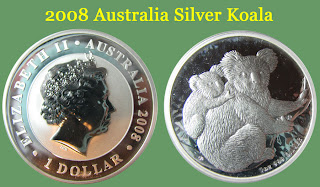 Rather than finding anything real interesting, I purchased some uncirculated 50 State Quarters to fill holes in my album. I also found a number of circulated early Lincoln Cents for a set of folders I am putting together. But the most interesting coin find was the 2008 Australia Silver Koala. Struck by The Perth Mint, this is the second year of issue for this 99.9-percent silver coin. Taking the lead from the Chinese Panda, the reverse features artistic depiction of the marsupial native to the eastern and southeastern regions of Australia. The obverse features the Ian Rank-Broadley effigy of Her Majesty Queen Elizabeth II.
Rather than finding anything real interesting, I purchased some uncirculated 50 State Quarters to fill holes in my album. I also found a number of circulated early Lincoln Cents for a set of folders I am putting together. But the most interesting coin find was the 2008 Australia Silver Koala. Struck by The Perth Mint, this is the second year of issue for this 99.9-percent silver coin. Taking the lead from the Chinese Panda, the reverse features artistic depiction of the marsupial native to the eastern and southeastern regions of Australia. The obverse features the Ian Rank-Broadley effigy of Her Majesty Queen Elizabeth II.
An interesting aspect of the reverse design is what the Perth Mint calls the “shimmer background.” The reverse background is textured background with full luster that helps the koala image stand out from the “shimmer” created by angling the coin under the light. It is an interesting concept that makes the coin a unique collectable.
One change Whitman made from previous shows was that the sales of Whitman Publishing products were in the lobby outside of the halls inside a plexiglass booth that can be locked at night. Although there are supply vendors on the bourse floor, only one general supplies dealer is there to offer discounts but they sell very few Whitman supplies. For this show, that dealer was moved to the opposite end of the hall from their previous location and had a smaller table area. Whitman owns the show and probably feels they should protect any profits they could realize.
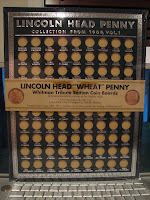
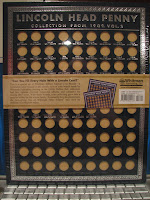 Capitalism aside, I do prefer Whitman albums and folders over other brands. In addition to buying additional pages for my Sacagawea Dollars album, I found the Whitman Tribute Coin Boards for the Lincoln Cents and Buffalo Nickels. Whitman calls these board “a commemorative reissue in the classic style of coin boards made by Whitman Publishing starting in the 1930s.”
Capitalism aside, I do prefer Whitman albums and folders over other brands. In addition to buying additional pages for my Sacagawea Dollars album, I found the Whitman Tribute Coin Boards for the Lincoln Cents and Buffalo Nickels. Whitman calls these board “a commemorative reissue in the classic style of coin boards made by Whitman Publishing starting in the 1930s.”
From what I can tell, these 11×14 inch boards are close to the original issues using modern materials and modern printing techniques. One addition to these boards are the mintage totals featured under the dates for each coin. The Lincoln Cent boards covers the wheat-back issues from 1909 through 1959, with no varieties, using two boards. The second board has 39 blank spaces following 1959 with no markings. Of course I will fill those in with Memorial back issues until I run out of holes.

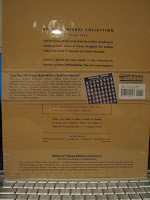 The Buffalo Nickel board collection requires a single board to cover the issues from 1913 through 1938 with no varieties—except for the 1913 issues where there are holes for the “Raised Ground” coins along side the ones just marked with the year. The nine holes at the bottom do not have date markings except for “NEW TYPE JEFFERSON NICKELS” above the boarder; Obviously, I will have to fill those holes with the appropriate nickels.
The Buffalo Nickel board collection requires a single board to cover the issues from 1913 through 1938 with no varieties—except for the 1913 issues where there are holes for the “Raised Ground” coins along side the ones just marked with the year. The nine holes at the bottom do not have date markings except for “NEW TYPE JEFFERSON NICKELS” above the boarder; Obviously, I will have to fill those holes with the appropriate nickels.
Although I have not removed the shrink wrap from the boards, I noticed the back of the Buffalo nickel board has a box that has the number for other boards. I wonder if this is a reproduction of the original board or an indication that Whitman will produce those coin boards in the future. It would be interesting if they produced other tribute boards in the future. I would certainly buy them.
Of course you cannot go through a bourse floor without talking with a few people. Some I saw in passing and did not get to speak with them. I saw Patti Finner, Vice President of the ANA, working at the Kids Table—something the native Baltimorean has done for many years. I spoke with her during the last Baltimore Show but did not have an opportunity this time. Walking from the parking garage and through a nearby hotel, I saw NGC’s Dave Lange dashing away from the Convention Center. That was too bad because I wanted Dave to autograph the coin boards! Considering his interest and books about vintage coin boards, I thought that would be great for these tribute boards. Oh well… maybe next time.
I spoke with many dealers who are really wonderful people. One of my favorites is Wayne Herndon. Amongst our conversations, we spoke about the recent eBay issues and how our future on the site will be effected. We agreed that eBay is not as cost effective as it has been and may not be worth using in the future since it hurts the small seller and sellers who are trying to work on slim margins to give collectors value. I have bought from Wayne in the past and will continue to buy from him. Even before we started to talk, I always thought his prices were fair.
When it came time to leave, I discovered that Whitman set the policy to only have the main doors to Halls A and B as the entrance-only and forced attendees to exit through the doors in Hall C. While Halls A and B create one large area, Hall C turns the space in the el-shape that people may be bypassing. Moving the exit to the doors leading out of Hall C may be one solution but it caused a problem for me and my hurt knee. Although my doctor said a four hour walk on the bourse floor should not be a problem, my knee was in a lot of pain. I was limping, even grabbing onto chairs, tables, and anything nearby to prevent from falling. I tried to exit the nearby main doors, but was turned away by the security guard. So I had to schlep around to the Hall C doors while staying close to the tables to maintain my balance. In the future, I hope Whitman would allow those leaving within the last hour of the day to exit the nearest doors.
If I had to rank this show with the others, it would rank below other Whitman sponsored shows and on par with those by the previous organizers. While I can have fun at a coin show with 20 dealers, one expects a show that spans three halls of the Baltimore Convention Center to be better. Hopefully my experience was an anomaly and the show on June 5-7 (with no Sunday hours) will reach their usual standards.
Dec 14, 2007 | books, coins, supplies
I received an email note from Whitman Publishing announcing new items including Lincoln Head Penny and Buffalo Nickel Tribute Edition Coin Boards. For those who do not know, coin boards preceded the ubiquitous blue folders for collecting coins. Whitman’s Tribute Boards are 11×16 boards using the same style as Whitman used in the 1930s. The Lincoln board set consists of two boards to hold 90 coins each covering the Wheat Cent era (1909-1958). The Buffalo Nickel board is a single board that holds 80 coins. It is a very interesting and fun revival of numismatic history.
To make this the ultimate numismatic gift, pair the boards with David Lange’s Coin Collecting Boards of the 1930s & 1940s and now you have a great gift for the numismatist in your life! To buy the book, go to www.coincollectingboards.com and buy the book autographed directly from Dave Lange. Autographed book and coin boards… how cool is that!
Aside from the new A Guidebook of Lincoln Cents by Q. David Bowers (does he do anything else but write books?), Whitman is offering free shipping for orders placed before December 18, free items depending on how much you spend, and a free copy of Bowers’ Inside Story of the State Quarters for all orders.
Remember, Wednesday was the last day of Chanukah and it’s 11 days until Christmas. I hope this helped.

















